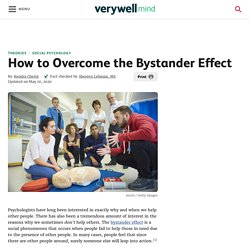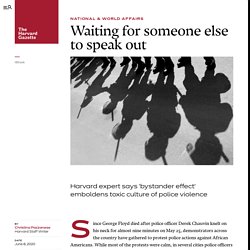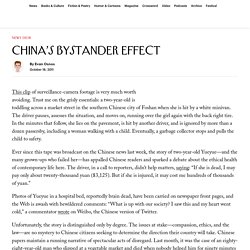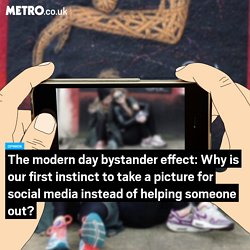

Video - Summary of Bystander Effect. Common Excuses of Bystander Effect. Filming > Helping. Pluralistic Ignorance. Image - Example of Pluralistic Ignorance. Desire to Conform. Image - Desire to Conform. Diffusion of Responsibility. Image - Diffusion of Responsibility. Asian Cultures. Tips to overcome Bystander Effects. Five-steps Decision-Making Process. Ask yourself these five questions...
How to Overcome the Bystander Effect. Psychologists have long been interested in exactly why and when we help other people.

There has also been a tremendous amount of interest in the reasons why we sometimes don't help others. The bystander effect is a social phenomenon that occurs when people fail to help those in need due to the presence of other people. In many cases, people feel that since there are other people around, surely someone else will leap into action.1 While the bystander effect can have a negative impact on prosocial behavior, altruism and heroism, researchers have identified a number of different factors that can help people overcome this tendency and increase the likelihood that they will engage in helping behaviors.2 Some of these include: Witnessing Helping Behavior Sometimes just seeing other people doing something kind or helpful makes us more willing to help others. Imagine that you are walking into a large department store. Being Observant Being Skilled and Knowledgeable Guilt Feeling Good. Overcoming the Bystander Effect.
How to foster a great sense of responsibility in kids so as to encourage them to help others? Watch What Would You Do? TV Show - ABC.com. An avoidable murder of a student caught on tape: the sickening power of the bystander effect. On Sept. 17, the life of a 16-year-old high schooler in Long Island ended tragically in a violent brawl outside a strip mall.

Khaseen Morris was told to show up outside the mall at a certain time by several others his age, after he was seen walking home the girlfriend of another boy. Morris showed up and was immediately attacked by a group of five teenagers. A senseless brawl erupted and Morris was stabbed repeatedly in the chest, dying later that night in the hospital.
The tragedy of Morris’s murder extends beyond the senselessness of his violent death and the fact that an innocent young life ended so abruptly over a trivial adolescent dispute. Bystander inaction, like 7-Eleven assault, more likely with more witnesses, experts say - Chicago Tribune. Police violence and the ‘bystander effect’ explained. Since George Floyd died after police officer Derek Chauvin knelt on his neck for almost nine minutes on May 25, demonstrators across the country have gathered to protest police actions against African Americans.

While most of the protests were calm, in several cities police officers have used force against demonstrators and journalists under the justification of crowd control. The sight of officers in riot gear beating marchers, firing rubber bullets and chemical- or pepper-based irritants, and shoving activists has reignited questions about accepted practices in the nation’s law enforcement community. Francesca Gino, Tandon Family Professor of Business Administration at Harvard Business School, studies leadership, the psychology of decision-making, and organizational behavior. She has written about how an organization can develop a culture that can turn harmful to its own people, to the success of its mission, and to its own reputation. China’s Bystander Effect. This clip of surveillance-camera footage is very much worth avoiding.

Trust me on the grisly essentials: a two-year-old is toddling across a market street in the southern Chinese city of Foshan when she is hit by a white minivan. The driver pauses, assesses the situation, and moves on, running over the girl again with the back right tire. In the minutes that follow, she lies on the pavement, is hit by another driver, and is ignored by more than a dozen passersby, including a woman walking with a child. Eventually, a garbage collector stops and pulls the child to safety. Ever since this tape was broadcast on the Chinese news last week, the story of two-year-old Yueyue—and the many grown-ups who failed her—has appalled Chinese readers and sparked a debate about the ethical health of contemporary life here.
Photos of Yueyue in a hospital bed, reportedly brain dead, have been carried on newspaper front pages, and the Web is awash with bewildered comments: “What is up with our society? 10 Notorious Cases of the Bystander Effect. The bystander effect is the somewhat controversial name given to a social psychological phenomenon in cases where individuals do not offer help in an emergency situation when other people are present. The probability of help has in the past been thought to be inversely proportional to the number of bystanders. In other words, the greater the number of bystanders, the less likely it is that any one of them will help. This list describes the prototype of the effect and cites nine particularly heinous examples. The Parable of The Good Samaritan First, the prototype of the bystander effect. Jesus then explains, with the following parable, that everyone is everyone’s neighbor, and that help should be offered to anyone in need of it, regardless of who or what that person is.
A Jew is going along the road, and is beset by bandits, who beat him severely, strip his clothes, and rob him. The modern day bystander effect: Why is our first instinct to take a picture for social media instead of helping someone out? This week a man shared a photo of a woman sitting on the tube, slumped over, with her pizza slipping from her lap and on to the floor.

‘Big night,’ wrote BBC reporter James Longman on Twitter. ‘(it’s 8am)’. How to cycle your way to a sustainable staycation The photo racked up more than 21,000 retweets, got covered by major publications, and prompted a lot of questions. Questions like, ‘was she on her way to work or on her way home?’ *Yes, probably. But looking at this photo, I couldn’t help wondering about the answers to some other questions – questions I wonder if James Longman asked before he decided to take a photo and blast it all over social media. Was that woman alright? Had she missed her stop? Was she comfortably snoozing or had she passed out, absolutely hammered to the point of struggling to stay upright?
It doesn’t look like James asked these questions. Right then. James told metro.co.uk that because the woman isn’t ‘recognizable’ in the photo, he doesn’t think there’s ‘any harm’. The 21st century bystander effect happens every day online. If you’re going to fall, injure yourself and need help, where is a good place to do it?

Should you choose a busy thoroughfare or a deserted backstreet? Statistics and experiments in social psychology will tell you that if you need help, you should avoid dropping in a busy street, even if hundreds of people are passing through.